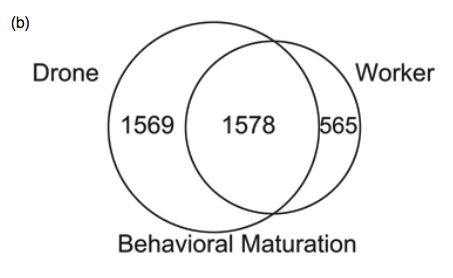New Paper: Drones are from Mars, Workers are from Venus!
I have a new paper out from a collaboration with Dr. Gene Robinson and his group at the University of Illinois at Urbana Champaign. [see YorkU Press Release]
Honey bee societies are composed of three castes and two sexes. Female bees are either queens or workers; the queen bee lays all the eggs, while the workers do pretty much everything else (build the colony by secreting wax, heat and cool the colony, guard it from intruders, nurse and care for young larva, and collect pollen and nectar). Male bees on the other-hand, have a somewhat more privileged life – their entire existence involves finding virgin queens and mating with them! They are fed by workers, but they do not help out with the day to day activities needed to maintain the hive. This form of social organization represents a major transition in animal evolution. How and why do workers forgo reproduction to help their mom and brothers reproduce ?
We are not very far from answering this question. Both queens, workers and drones have the same genes, and some of the recent advances in the field have come from seeing which genes get turned on or off at different times during the bee’s development to give rise to the distinct castes of honey bees.
Queue-in the bee battle of the sexes! Worker bees and drones have some interesting similarities and differences. Drones and workers spend a period of time inside the hive, prior to initiating mating and foraging flights respectively. This transition from in-hive to out-hive activities are also ‘regulated’ by similar hormone and genetics in both drones and workers. For example, juvenile hormone increases the onset of mating and foraging in drones and workers respectively. Also, colonies where workers start foraging early have drones that start going on mating flights early. So it appears that maturation of drones and workers are under the common control of genes and physiology.
What then accounts for the big differences in behaviour between the two? Workers are much better learners (they take fewer risks!), navigators (they don’t get lost as easily!), and they are extremely sensitive to their environment (they can pace their maturation in tune with the queen and their sisters’ needs). The foragers also perform the ‘waggle dance’, which communicates information about the location and quality of food resources to their sisters.
We set-out to study differences in the brains between drones and workers. We collected drones and workers at two time frames; when they are very young and are still in the hive, and after the onset of mating flights and foraging flights. We dissected the bees, and examined which genes are turned on or off in their brains. We found massive differences in the brain profiles of drones and workers (~ 40% of genes had sex-difference).

Venn diagram showing changes in brain gene profiles associated with maturation in workers and drones. From Zayed et al 2011
Many of the genes that showed sex-differences are known to play a role in behaviour, learning and memory in solitary critters like the lab mice and the fruit fly. But the interesting part was that most of the changes in brain profiles that we observed as workers matured were also present in drones. This suggests that the shift from nursing to foraging in workers was built upon an existing program for maturation in insects.
The study opens the door to understanding the genetic and molecular basis of worker behaviour, and how these social behaviours evolved.